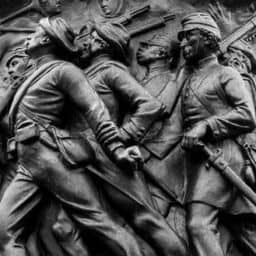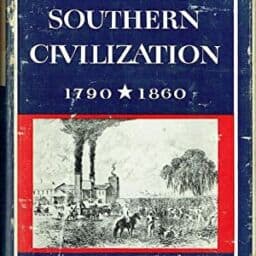Genovese, Eugene D. The Political Economy of Slavery: Studies in the Economy & Society of the Slave South. New York: Pantheon Books, 1965.
1. Thesis: “Slavery gave the South a social system and a civilization with a distinct class structure, political community, economy, ideology, and set of psychological patterns and that, as a result, the South increasingly grew away from the rest of the nation and from the rapidly developing sections of the world.” All of these factors contributed to a closed system that was slow, if not resistant, to change as a means of protection of power and way of life for slaveholders.
2. Structure: Genovese dissects the Southern civilization in his book with four distinct parts. Part 1 examines the overall setting of the Southern society (state of the wealthy, the banking aristocracy, social tendencies and tone, power and paternalism). Part 2 examines the deficiencies in land use and slave labor (low productivity, African influence, crop selection, soil exhaustion, livestock issues, technological limits, reform limits). Part 3 discusses towns versus country, factories versus plantations and slave versus free labor concerns. Part 4 ties everything back together by examining the overall crisis in the South, including the need for (and limits to) expansion, refuting revisionist “natural limits” theory.
3. Evidence to support thesis (slavery as a cause of all of the following):
- Low Slave Productivity/Use: “careless and wastefulness” (p.43), negroes only good for one task at a time(p.43), “slaves worked well below their capabilities (p.44), diet/malnutrition factors (p.44), plenty of slaves but still wasted money bringing in specialized labor (p.53), slavery undermines “culture, dignity, efficiency and manhood” (p.81), different institution from that of Africa, not better (p.78)
- Crop and Soil Problems: lack of precision techniques (p.89), impractical use of manure and guano (p.95), unstoppable exhaustion linked to one-crop choice (p.99), focus on main crop only, assigned worst lands to other crops (p.134)
- Poor Livestock: careless treatment/abandoned to wild (p.110), slavery prevented investment in livestock (p.112), hog treatment bad – imports (p. 115), cattle issues = soil exhaustion (p. 117)
- Stagnant Technology: due to abundance of menial laborers (p.50), cheap tools where possible (p.58), “hostility to innovation…grew out of the patriarchal social structure” (p. 66)
- Slow/No Reform: no organization for agrarian reform/no state support/strength/presence – “few attended except politicians (p.127), “more interested in social activities than practical affairs” (p.128), low membership in reform societies – 90k North vs. 8k South (p. 128)
- Market Issues: North had home market for manufactured goods, South no home market – importer of goods for consumption/exporter through North to outside markets for raw materials – control issues/capital outflow/no capital inflow (p. 160), Clay on markets (p. 173)
- Infrastructure issues: lack of railroad connectivity (p. 164), small concentration of land led to smaller markets of poor people with little purchasing power (p. 168)
- Ideological struggle between Plantation and Industry: plantation slaveholders afraid of manufacturing industrialists – might make money and gain power over their interests (p.182), issue of raising slaves and poor whites to an industrial class dangerous? (p. 221), danger of training slaves for manufacturing (p.225), put white poor in factories to morally educate and control them/protect from abolitionists using them to incite revolt (p. 228), slavery keeps out European immigrants (p. 231), threat of industrial union growth/labor militancy (p. 232)
- Necessity for Expansion: expressed desires to push into Central and Latin America, movement by Confederate troops towards Mexico in war, desire to annex Cuba (p. 258)
4. Convincing/Criticisms? Reading about the South from his perspective reminds me of my studies of British and Spanish colonialism towards early Latin American countries. Much like Argentina, Brazil, Chile and others, the South produced raw materials for export and did not create its own home market for its goods. In both instances of dependency, those in power were slow to change their agrarian systems and hesitant to adopt industrial progress for fear of the loss of their paternalistic, hegemonic power over society. External interests (such as the North) sustained industrial growth by feeding from the South’s raw material production. They, in turn, manufactured goods from these raw materials to sell back to a hungry Southern market. If the South had developed their own agri-industrial home market, they might have retained their wealth within the South and advanced as a society. Such advancement, however, would have come at the cost of slaveholder societal power control, revealing the paradox of the slave system. Once slavery had taken hold, those in power could not get rid of it. If so, they were damned if they did and damned if they did not.



